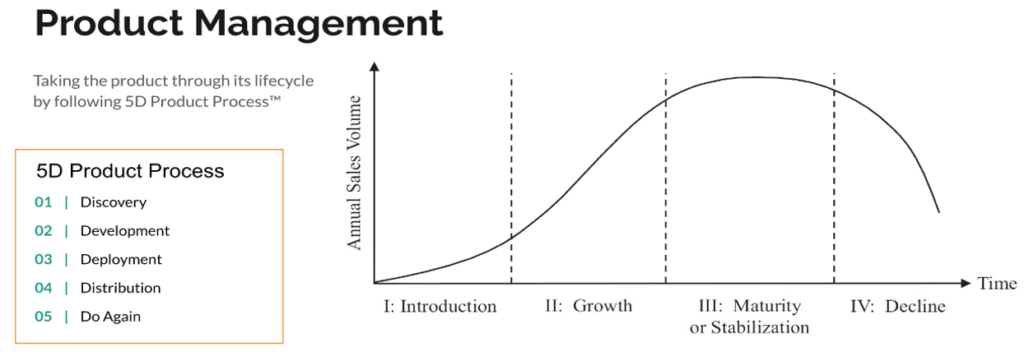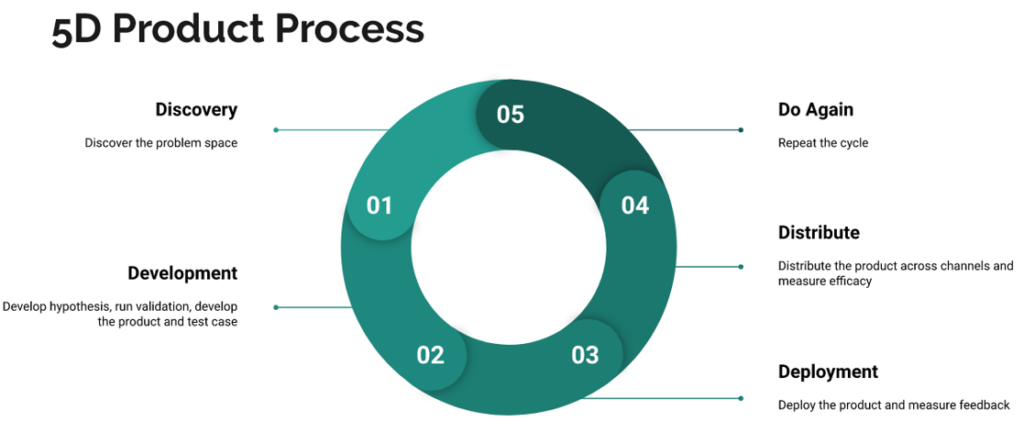Product management is the process of overseeing the development, marketing, and sales of a product, from conception to retirement. It involves understanding customer needs, defining product features and specifications, working with cross-functional teams, and monitoring the product’s performance over time. The goal is to ensure that the product meets customer needs, generates revenue, and remains competitive in the marketplace.
5D Process for product management
The 5D process provides a structured approach to product management and helps product managers to effectively develop and launch products that meet customer needs and drive business success.


History Of Product Management
Product management has its roots in the early 20th century, but the role of product managers became more formalized in the 1930s. Since then, product management has evolved to become an increasingly important function in many industries, adapting to new technologies and processes over the years. Today, product management remains essential to the success of any company that produces or sells products.
Roles in Product Management
Jack of All Trades

Product Manager
Product Owner
Project Manager
Program Manager
Marketing Manager
UX Designer
Sales Manager
Skill Set for Product Manager
A product manager should have a diverse range of skills to be effective in their role, including:


The 5 Buckets for Product Management
Five buckets of product management, explained in simple words:
Strategy: This bucket involves setting the vision for the product, defining the goals and objectives, and identifying the target market and user needs. It’s about determining what to build and why.
Planning: Once the product strategy is in place, the planning bucket involves breaking down the strategy into actionable tasks, creating a roadmap, and estimating the resources required to complete the tasks. It’s about figuring out how to build what you’ve decided to build.
Execution: This bucket is all about actually building the product. It involves managing the development team, making sure everyone is working towards the same goal, and keeping the project on track. It’s about ensuring the product is built to the specifications outlined in the planning bucket.
Launch: Once the product is built, the launch bucket involves introducing it to the market. This includes creating a marketing plan, developing sales materials, and training the sales team. It’s about ensuring the product is successful in the marketplace.
Monitoring: This bucket involves tracking the success of the product over time. It includes monitoring user feedback, measuring key performance metrics, and making updates and improvements to the product as needed. It’s about ensuring the product continues to meet the needs of its users and remains relevant in the marketplace.
Product Management Maturity Scale
The Product Management Maturity Scale is a framework that assesses how well a company manages its products. The scale has five levels:
Ad hoc: No formalized product management practices are in place.
Emerging: Product management practices are starting to be developed, but not consistently applied.
Established: Product management practices are well-defined and consistently applied.
Mature: Product management practices are optimized and continuously improved.
Leading: Product management practices are innovative and industry leading.
Every company’s level will be different, and the scale is not necessarily linear. The goal is to identify where a company falls on the scale and work towards continuous improvement.

What Maturity Looks Like
Maturity in product management involves having a Orientation, Scope, Accountability, Ways of working, Talent & Skills, strategic focus, being customer-centric, collaborating cross-functionally, using data to inform decision making, and continuously improving the product over time.




1 thought on “Ways of understanding Product Management”